If you’re here looking for gluten free cookie baking help, you’re not alone. Many people have trouble with their gluten free cookies — too thin, spread too much, too crispy, too cakey, too crumbly, too dry, overbaked … there are so many ways gluten free cookies can go wrong. But the good news is that there are so many ways to fix these problems! I have 17 gluten free cookie baking tips for you to bake yourself to cookie nirvana.
And no worries if your gluten free cookies must also be dairy-free … did you know that all the recipes on my site are both gluten free and dairy free?
But what if they must be egg-free, too? Would it surprise you to learn that using Ener-G® Egg Replacer instead of eggs actually helps keep most gluten-free cookie recipes from spreading?!) For more egg substitutes and tips, hop to my vegan egg substitutes article!
While most people tend to get a bit frustrated with their “free from” cookie baking results, if you keep these 17 tips handy next time you’re baking cookies, you’ll be baking your way to soft, chewy gluten free cookie success!

17 Gluten Free Cookie Baking Tips
1- Make sure your ingredients are the right temperature.
Follow the recipe directions for ingredient temperatures, and if none are noted, use this rule of thumb for all recipes, not just cookies: ROOM TEMPERATURE INGREDIENTS. This does not mean soft butter and it doesn’t mean cold eggs. It means everything should be as if you left it on the counter for an hour or two, ~70 F/20 C.
For cookies though, you have a choice when it comes to butter temperature.
- Room Temperature Butter = soft, fluffy cookies
- Soft Butter = soft cookies, cookie spread
- Melted or Browned Butter = chewy, flat cookies with crispy edges
- Cold Butter = thicker, crispier cookies
2- Cream the room temperature butter or shortening with the sugar with an electric mixer before doing anything else.
This step will help whip up the butter or shortening and make it fluffier by incorporating air into the batter, while also breaking down the sugar a bit, so that it doesn’t melt as much (e.g. spread) when baking. Unless you like your cookies very crispy and flat, don’t melt the butter, just use room temperature butter (around 70 F) — it should still be firm, but not cold.
3- Bake with a combination of fats.
Butter (or non-dairy butter alternative – i.e. Earth Balance® Buttery Sticks — NOT spreads because they … spread! — see my dairy-free butter recommendations here) and shortening or oil, rather than just butter alone works well to hold gluten free cookies together, giving more body to the dough to prevent spreading. {To see more on the benefits of this combination, see my video!}
The shortening I recommend is Spectrum Palm Oil Shortening — it’s organic, Fair Trade Certified and Sustainable Palm Oil Certified. It’s also non-hydrogenated. It works well when you’re experiencing cookie spread.
4- Always cover cookie sheets with parchment paper unless the recipe directs otherwise.
It promotes even baking, prevents cookies from sticking to the sheet (and then breaking apart when removed), doesn’t leave a greasy aftertaste on the bottoms of the cookies, and helps you spend less time in the kitchen doing clean-up duty when you’re done – BONUS!
5- Chill your dough well before baking.
(Particularly when dealing with rolled cookie doughs) A lot of gluten free bakers will tell you to chill doughs to minimize grit — this isn’t necessary with gfJules Flour because there is NO GRIT! But it’s a good idea in warm kitchens, if you’re working with browned or warmed butter, or if you’re rolling the dough. It reduces stickiness of gluten free doughs and also can enhance the flavor, but again, it’s not necessary with gfJules Flour or Cookie Mixes. If you find your cookies are too crispy for your liking, do not chill the dough before baking.
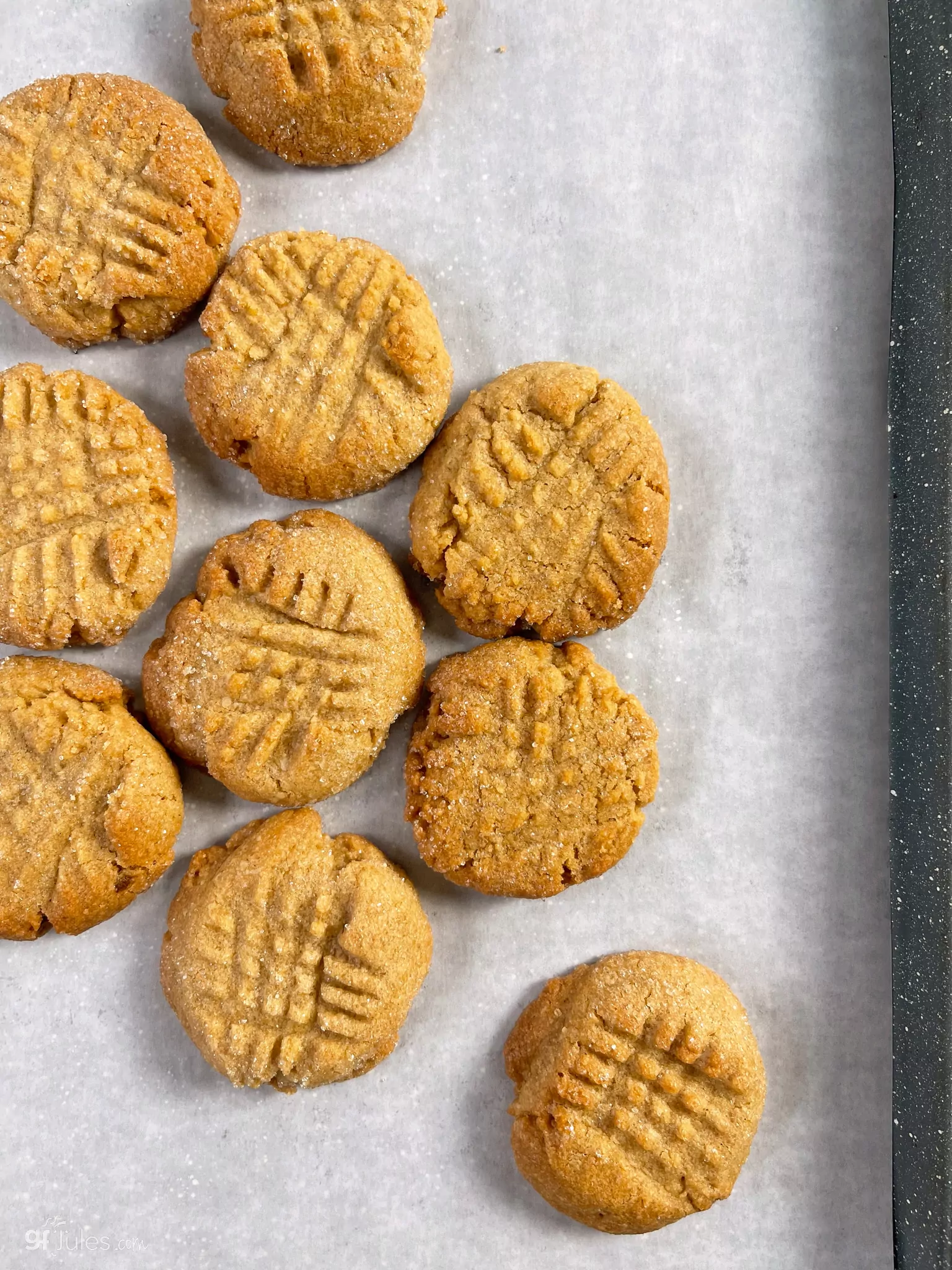
6- How to I get my cookies to be less thin?
If your cookies are too thin and crispy, use soft butter, do not chill the dough, bake less time and consider raising the temperature of your oven by 25 degrees. You can also substitute brown sugar for granulated sugar (or some proportion thereof) to help bring more softness and chew to your cookies. If you can tolerate eggs, try adding an egg yolk to your cookie dough for even chewier cookies.
7- How do I fix crumbly gluten free cookie dough?
If your cookie dough is too dry and crumbly, just add back to the mixing bowl and stir in a couple tablespoons of your favorite milk or an egg. Add more if needed – the dough needs to hold together, but most cookie doughs shouldn’t be sticky. Sometimes I’ll keep cookie dough in my fridge or freezer and when I go to bake some, the dough has dried out from the cold. Same solution: bring to room temperature then mix in a few tablespoons of milk. Voila – cookie dough like new!
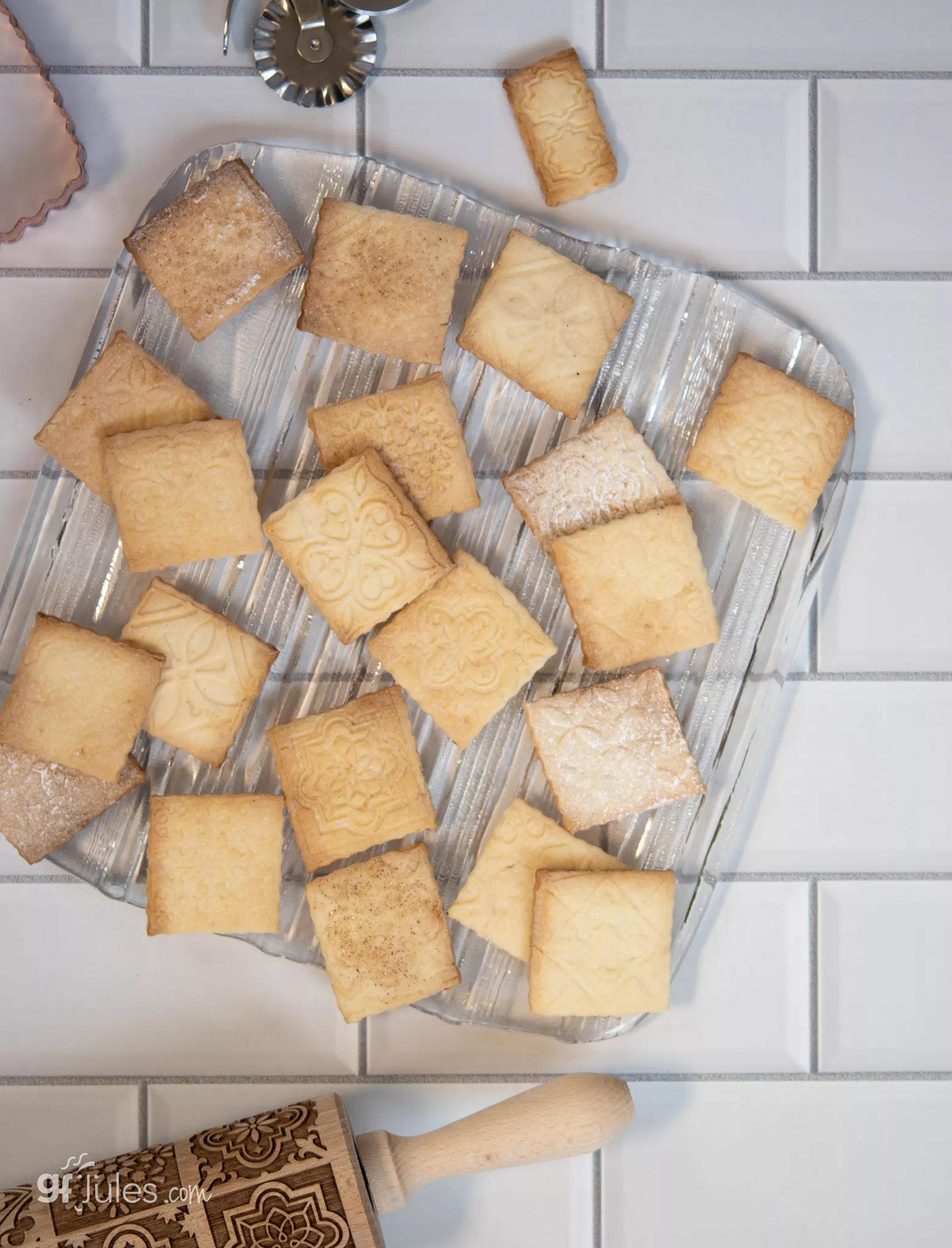
8- Bake by weight.
Bake by weight, as opposed to volume (using cups), is always more accurate. One measured cup of my gfJules All Purpose Gluten-Free Flour should weigh 135 grams. If using my gfJules Multigrain Biscuit and Breakfast Baking Flour (corn-free), 1 cup weighs 140 grams. If using my grain-free Nada Flour, 1 cup weighs 110 grams.
Measuring your ingredients inaccurately can throw any recipe off, especially finicky cookie recipes! Read more about how to accurately measure your gluten free flour in this post, and grab a kitchen scale here — you won’t regret it!

9- Don’t put too many additions into any cookie recipe.
For example, with chocolate chip cookies, adding too many chocolate chips will cause the cookies to spread, as there is not enough dough to bake up for support. This is one reason why I like using Enjoy Life® MINI chips (and they’re dairy, soy & nut-free, too!).
10- Add extra gluten free flour.
If your cookies still insist on spreading, add an extra 1/4 cup of my gfJules Gluten Free All Purpose Flour to the remaining dough to help hold them together (also helps at high altitude!).
11- Make sure your baking soda and/or baking powder are fresh.
These are the leavening agents in your cookie recipe and if they are no longer active, your cookies won’t puff up and may spread more. Try a fresh container if they’ve been open longer than 3 months.

12- Let your cookies cool before removing them from the parchment.
I slide the parchment onto wire cooling racks after 5 minutes or so, and let them fully cool before I remove them. Allowing them time to set after baking prevents them from falling apart during transfer. Once they’re cooled, they are no longer fragile … but still chewy and delicious!
13- Use convection settings.
If your oven has the option, try baking using convection settings, rather than static temperature. If you have a convection setting on your oven and a convection temperature is not given, simply reduce the static temperature by 25 degrees when using your convection setting and bake for a bit less time. Watch closely so you don’t over-bake!
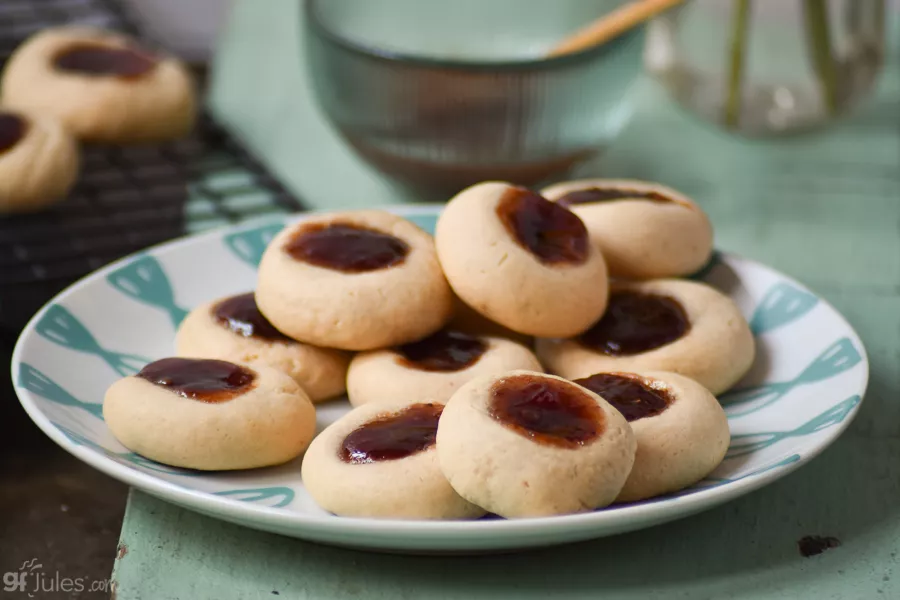
14- Reduce oven temperature.
In fact, go ahead and reduce the temperature on your oven by 25 degrees anyway. If your oven is baking too hot (shockingly, most ovens don’t cook at the accurate temperature!), your cookies will definitely spread! The sugar in the dough may even sneak out the sides of the cookie and form a lacy texture. If this is happening, try baking the next batch at a lower temperature and see what works best with your oven. Also rotate your baking sheet halfway through the bake cycle to promote even baking.
15- Take your cookies out BEFORE they look done.
With chocolate chip cookies, for example, I remove them when the centers still look a bit doughy. As they cool, they are still cooking. Taking them out of the oven at this point will ensure that they stay chewy!
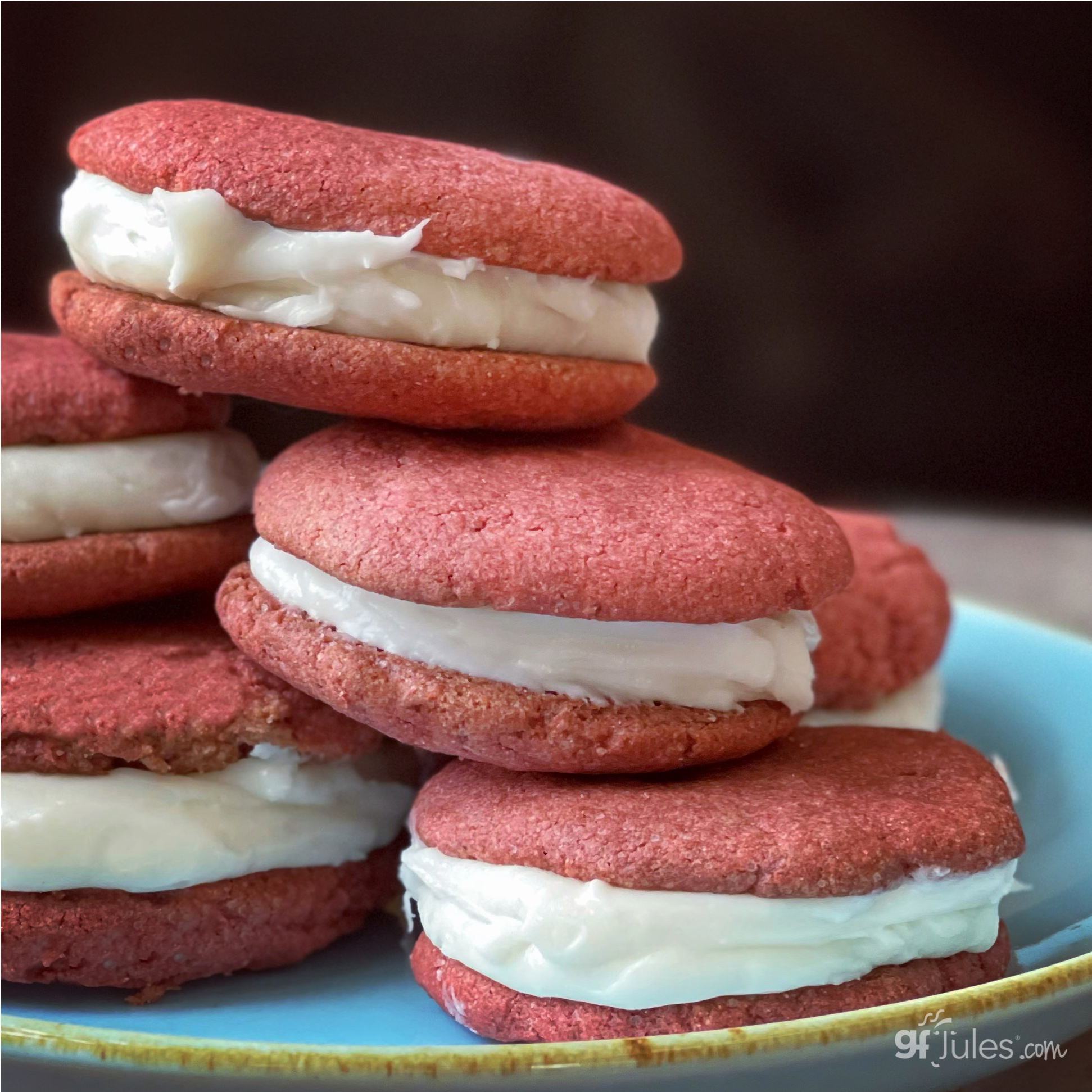
16- Use a tried and true gluten free cookie mix.
It’s faster and easier than weighing out and adding other ingredients, and you’ll know that it works! Try my delectable and uber-versatile, award-winning gfJules Cookie Mix and my easy gfJules Sugar Cut Out Cookie Mix!
And don’t forget homemade gluten free graham crackers with my gluten free Graham Cracker/Gingerbread Mix!
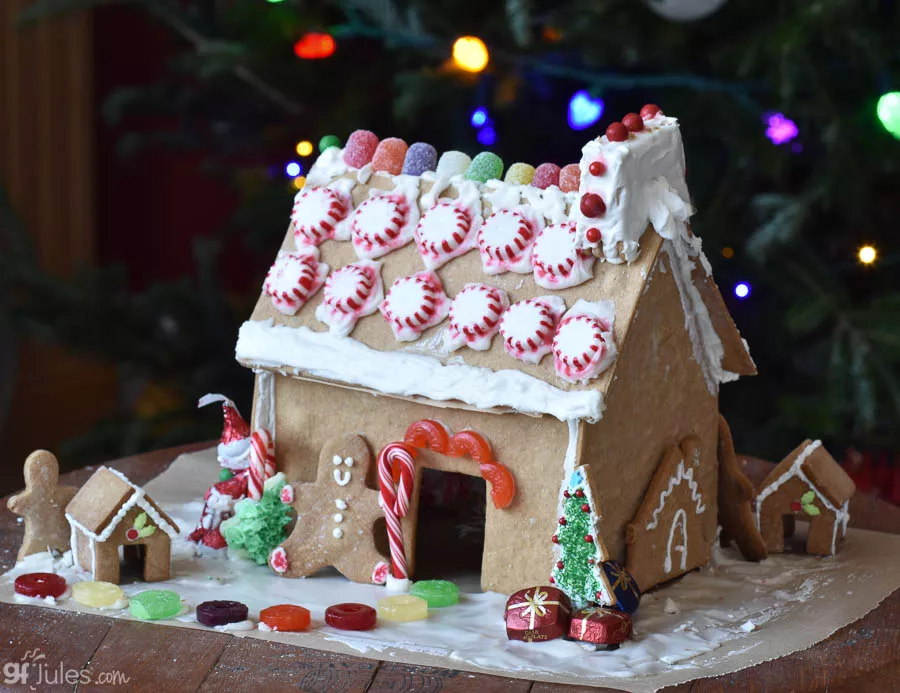
17- How do I store gluten free cookies?
You have two options: freeze gluten free cookie dough or freeze baked gluten free cookies. *Note, for cookies made with gfJules Flour or Mixes, they stay fresh for up to a week if stored in an air-tight container on the counter after baking.
To freeze gluten free cookie dough, place cookie dough balls on a parchment-lined baking sheet that will fit in your freezer. Freeze until cold, then transfer to a freezer bag and return to the freezer. To bake, just follow the cookie recipe directions but lower the oven temperature by 15 degrees and bake about 2 minutes longer.
To freeze baked gluten free cookies, either place on a parchment-lined baking sheet that will fit in your freezer and freeze until cold then transfer to a freezer bag or simply place in a freezer bag and store in the freezer for up to 3 months.

♦Want the gluten free recipes for my Vanilla Wafers, Oatmeal Cookies, Hamantaschen, Spritz, Snowball Cookies, Chocolate Crinkle Cookies, Sugar Cookies, Peanut Butter Cookies, Red Velvet, and Lemon Shortbread, among others? Search my RECIPES tab or the search bar at the top of every page and you’ll find over 60 gluten free cookie recipes for the taking!♦
And don’t forget to sign up for all things Gluten-Free Cookie by joining the Gluten-Free Cookie Swap – your community cookie recipe share site on Facebook!
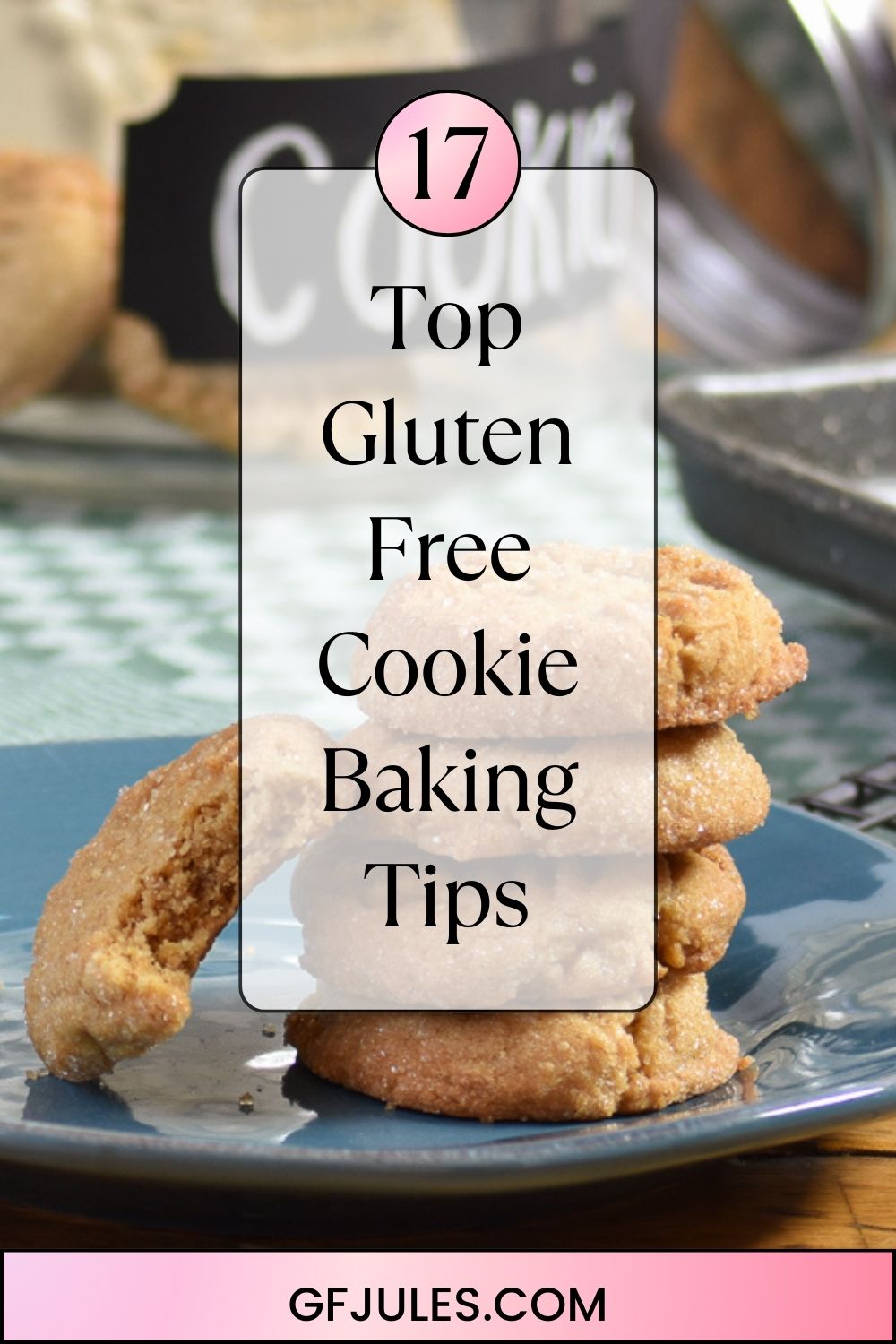


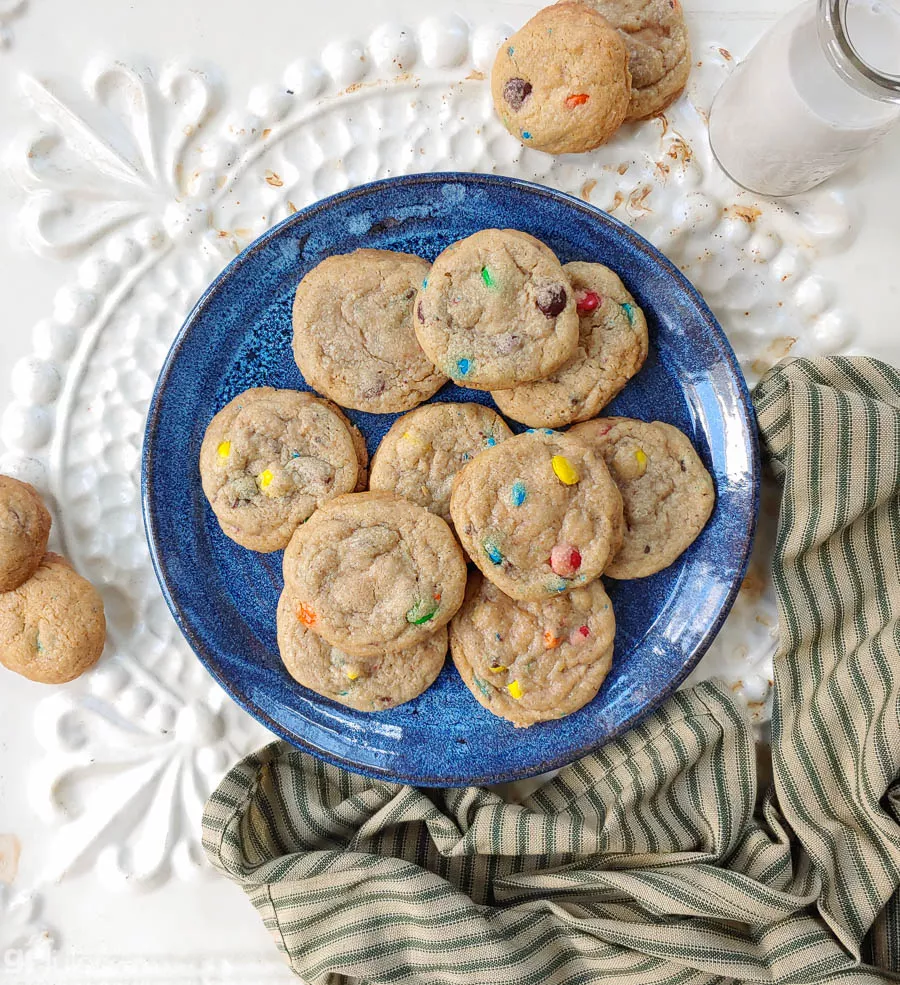
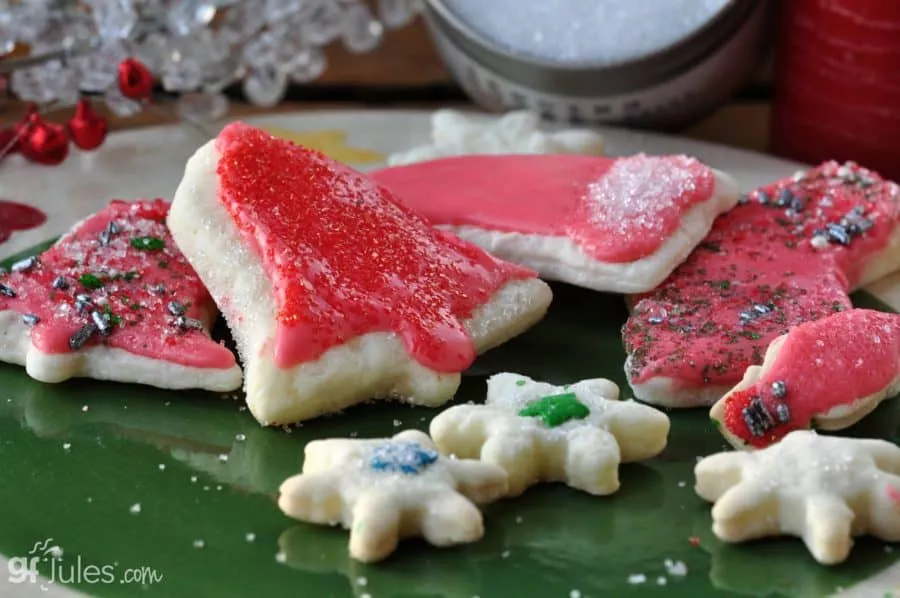
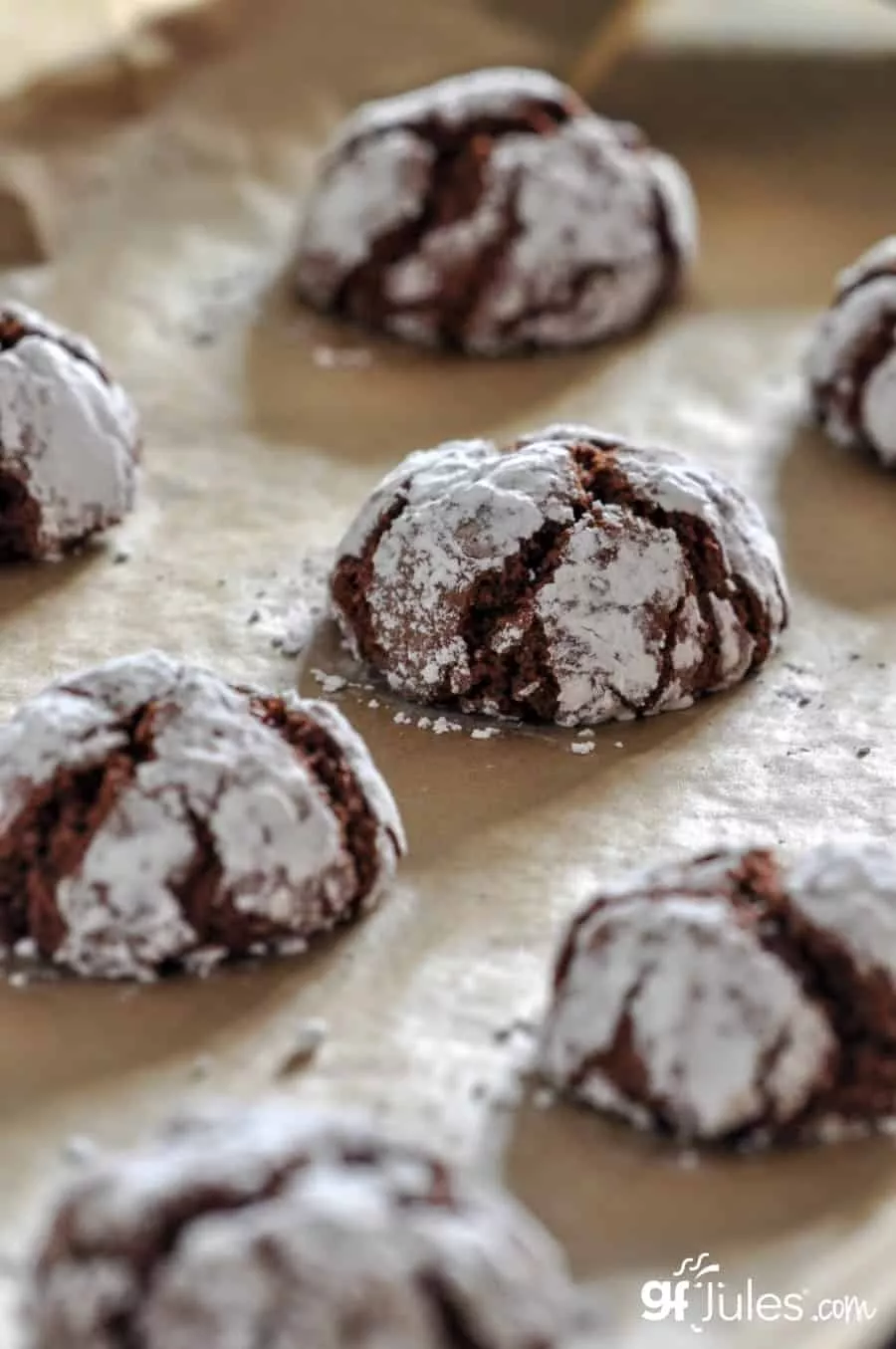
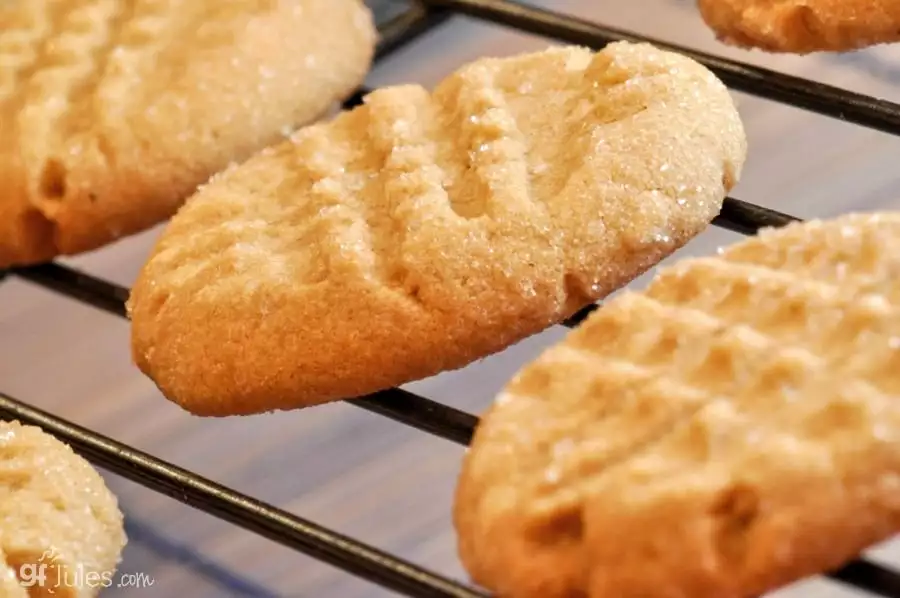

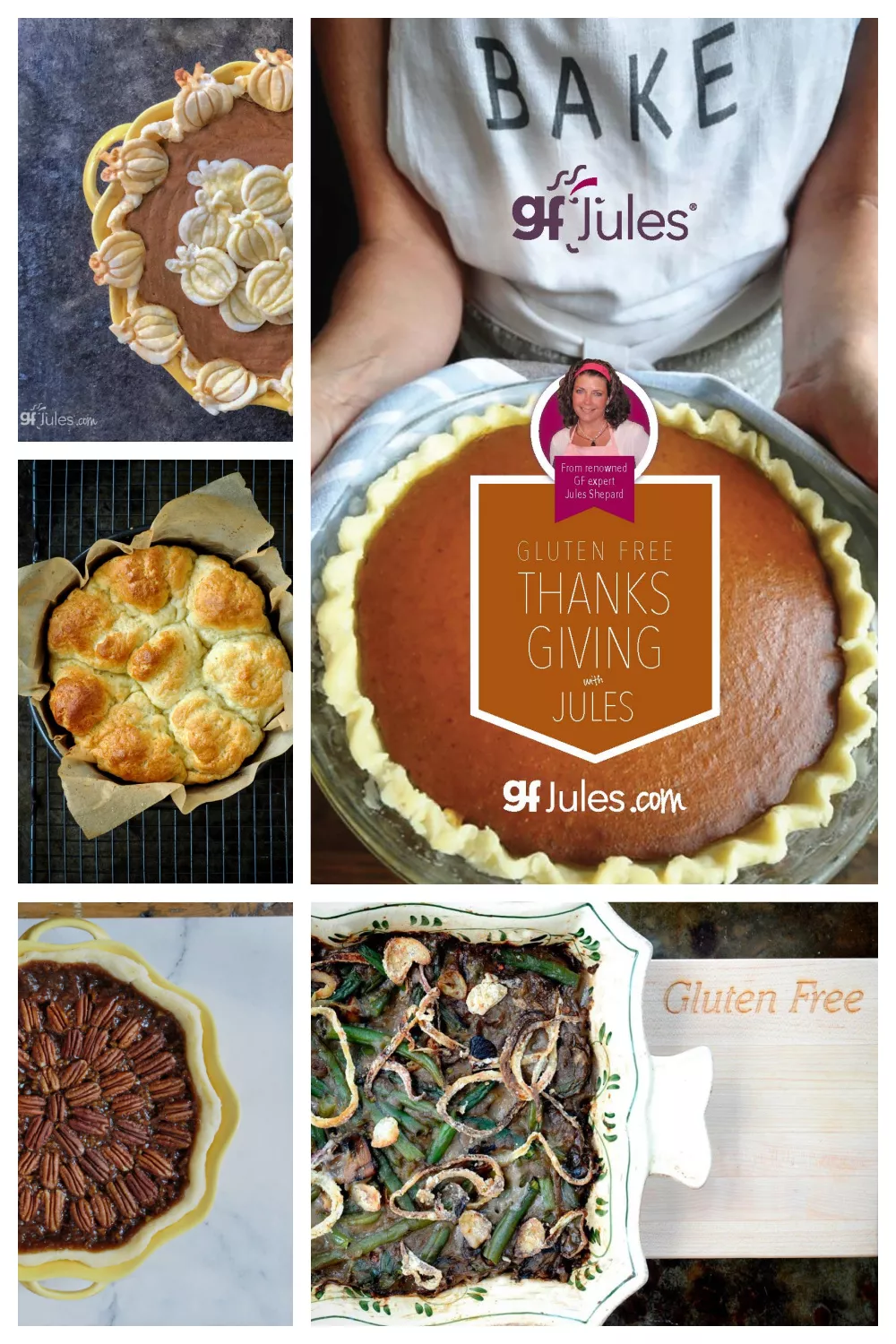




 (4 votes, average: 3.75 out of 5)
(4 votes, average: 3.75 out of 5)











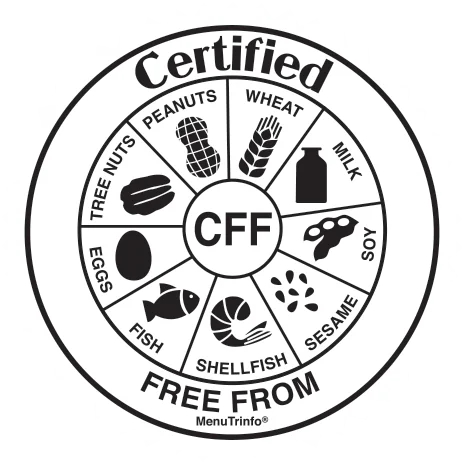


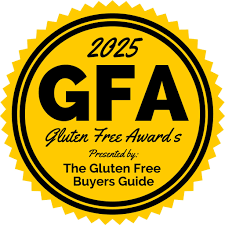

Can you use your flour now for biscuits if the floor says best by 7/19/23
If my flour has been stored sealed, away from moisture and does not smell funny or have any odd color to it, it’s probably still ok. It doesn’t have a high protein or fat content to go rancid, unlike a lot of other gluten free flours. However, it IS past its prime, so you’ll want to keep that in mind if things don’t work out exactly as you’d hoped. I would get a fresh bag as soon as possible!
~jules
Thank you for sharing your helpful hints making GF cookies. The cookies I made were choc.chip cookies, but there was not eggs in the recipe. Can I add a couple of eggs in already mixed dough. I only baked off a dozen cookies and they all crumbled . this is my first request, please answer.
Hi, without seeing the recipe it’s hard for me to say what might have happened to your dough. Usually crumbly gluten free cookies can be caused by using rice-based gluten free flours, not using eggs (which you said you didn’t), not enough liquid or other fats or a combination of these things. It would be nearly impossible to go back and add eggs to dough once mixed, but you may be able to incorporate more liquid. You could try putting room temperature dough back in the mixing bowl and adding aquafaba or milk to make the dough less crumbly or you could also try baking the rest of the dough in a parchment-lined square baking pan (like a brownie pan) to make the dough into bars which often hold together better than single cookies. I hope one of these works out for you, and next time, try using a different recipe with eggs or maybe look for a different gluten free flour with less rice flour and more starches.
~jules
Thank you for sharing your helpful hints making GF cookies. The cookies I made were choc.chip cookies, but there was not eggs in the recipe. Can I add a couple of eggs in already mixed dough. I only baked off a dozen cookies and they all crumbled .
My cookie recipe doesn’t list baking powder (It’s a reg flour recipe) but I need to convert to gluten free. So should I add baking powder to help it stay in a round ball through baking. If so how much per cup of flour.
Hi Wendy, it really depends on the kind of recipe it is. Here are my general tips on converting recipes to gluten free. Keeping the shape may be more a function of the dough being cold and baking on parchment than using baking powder, but check out those tips and also see if I have a recipe on my site for the same kind of cookie and compare the recipe to see what my proportions and ingredients are for guidance.
Hope that helps!
~jules
My grandson has to be on a GF and dairy free diet. I am familiar with GF as my daughter has celiac. The dairy free is throwing my baking off I think. I am trying my best to make things normal for my grandson. My first exempt at making cookies was not great. They tasted wonderful but spread too much. I did chill the dough for an hour. Should I be freezing the dough first?
Hi Donna, check out my dairy free substitutions post for my favorite products and see if any are in your stores. The best tip I have is not to buy a SPREAD for a butter sub, but buy a dairy-free baking sub in sticks. I don’t prefer the “Melt” brand product, but I have had great results with Earth Balance and even the Country Crock vegan sticks. Otherwise, I haven’t had problems with any of my cookies and spread issues, so it might be a measuring issue with flour. Check out this post on measuring gluten free flour. And of course, look at your other ingredients: if you’re using the wrong gluten free flour blend, or one without binders, then it just won’t hold together well. Are you using my gfJules Flour blend? I use it in all my gluten free and dairy free cookie baking and it works wonders! By the way, ALL the recipes on my site are not only gluten free but dairy-free as well! Have fun baking and hope these tips help!
~jules
Can I use butter flavored crisco along with a stick of butter instead of all butter for gluten free cookies? I notice if I just use butter my cookies get flatter.
Yes, that’s a great option, Lori! Using all butter does tend to make the cookies flatter and spread out more; shortening adds more “body” to the dough and helps the cookies to keep their shape.
~jules
May I add a comment? I always use a cookie scoop. It will give you uniform sized cookies which look good in presentation. When I am making a cookie assortment, using the same size scoop keeps all the cookies a consistent size and are easier to arrange on a tray.
So glad you added a comment Nora! A baker’s dozen plus one from Nora is a welcome addition! What size cookie scoop is your favorite, or do you have several and use differing sizes for different types of cookies? I struggle to find just the right one for the job, sometimes! But I totally agree that uniformity saves the day on a cookie tray and cookie scoops are also a time saver when making loads of cookies.
~jules
When I am making varieties for a cookie platter, I use a #100 scoop. It makes a nice bite-sized cookie. Let’s face it, when there are many choices, a smaller cookies means you don’t feel as guilty trying more than one!
Nicely put, Nora! Bite sized means, no calories, right?!? 😉
~julse
How do I clean a previously used cookie sheet well enough to use it for gf cookies? Do I need to buy all new baking pans/ And, since I’m asking, is it safe to use my old glass and stoneware baking dishes?
Hi Cheri, good that you’re asking these questions, and I do have some answers for you. I’d suggest that you definitely read my article covering topics like this first, and to answer specifically about pans like glass, you should be totally fine with glass without worry. Stoneware is a bit of another issue, as it’s so porous. It comes down to how clean you really think you can get it. Parchment is really your best friend and I just tend to keep my old pans if I love them and just line them with parchment because it makes clean up a breeze and then I never have to worry about gluten cross-contact. I hope that helps!
~jules
Thanks for suggesting that one should use fresh baking soda since its what makes the cookies puffy. My wife and I are spending our first Christmas alone, and I want to bake some treats. I will be sure to get the ingredients and some trays to make plenty for work s well.
You’re very welcome, Eli! Wishing you and your wife a very happy Christmas!!
~jules
What is the best way to store fresh baked gf cookies? For example, snickerdoodles or cut out sugar cookies. Thanks.
Hi Deanna – great question! I never recommend the refrigerator for storing gluten free baked goods (or any baked goods, for that matter), as it just dries them out. I either store in a tupperware on the counter or in a plastic zip-top bag. Especially when using my gfJules Flour (it has a natural preservative in it), they last for many days on the counter stored this way. For baking far in advance of serving, you can also freeze them which works well. Enjoy!
~jules
Gluten free baking is not forgiving. One mistake can be enough to ruin the dough or batter. Drives me nuts!
It’s true in many recipes, but in lots of others, it’s pretty easy! My gfJules Flour also helps a lot. Especially if you know what the batter is supposed to look like because you’ve made it before with wheat flour, you can add liquid to get it to that point and it generally turns out well. There are definitely some tricks along the way though. Hope this article was helpful!
~jules
Hi Jules,
Not sure this is the right place to ask this, but I want to make a Muscadine Cobbler for this weekend and the recipe calls for Self Rising flour. What do you recommend I add to make your flour self-rising?
I was hoping that your flour would act like regular flour, so I added the 1 1/2 tsp Baking Powder and 1/2 tsp. salt and the recipe turned out great. When I take (and label) GF items to the potluck, many avoid the offering, but I guess if you label anything with “Muscadine Grapes” here in the south the folks gobble it up, with or without gluten! It was a hit.
LOL! Mary Ellen, I think that sounds like a win, in the South or otherwise! So glad you loved my flour and it worked to fool everyone at the potluck!
~jules
Hi Mary Ellen – I’m sorry I didn’t see your question until after you worked it out for yourself, but it sounds like all went swimmingly! If you ever have a pressing baking question, feel free to email Support@gfJules.com. Happy baking!
~jules
I used your flour in a gluten free cookie recipe and the dough is unbelievably tough and gummy. How can this be fixed?
Hi Hannah, many gluten free recipes call for extra butter/shortening and sugar and other gums to hold their recipes together and cover up for bad tasting flours or gritty textures. My flour is much more akin to regular wheat flour and doesn’t need all that extra stuff thrown in, so that might be the problem. Here’s an article on converting recipes that might help for future recipes. I would recommend using my flour in non-gf recipes, but if you want to use that recipe again, just add some milk or egg to the dough before you finish mixing to loosen the dough up and make it softer so that it can spread in baking and become soft.
Hope that helps!
~jules
Will try that, thank you! I did refrigerate the dough and they taste wonderful, but they don’t really spread out at all, so I will add a bit more liquid next time around!
Great! Hope it helps!
~jules
I’d like to add a cookie baking hint. Use a cookie scoop. Uniform sized cookies look so much better. Taking this a step further, when doing multiple varieties of cookies, such as for holiday platters, cookies of the same size make assembling platters easier and more attractive.
Great tips, Nora!
Happy baking!
~jules
I am baking GF cookies for my daughter’s wedding reception (Italian cookie table). We will need 100 dozen cookies of different kinds. Can I successfully freeze GF cookies for several weeks? Or should I only freeze the dough? How best to thaw that many cookies? Or should I just plan to bake them all during the last few days before the reception and store in well-sealed plastic containers??
Thanks for your help…
Hi Bev, how fantastic that you’re making GF cookies for your daughter’s wedding reception! I did the same thing last year for my wedding. My favorite, of course, were the Mexican Wedding Cookies! As for early prep for the cookies, you can certainly make up any and all the doughs and freeze them without problems. Most, though, will be find to freeze and just set out at room temperature before the reception to thaw (if they’re frozen well-sealed, as you note). The only ones I’ve tried and don’t love after they’ve been frozen are sugar cut-out cookies, but maybe I left them too long. At any rate, some combination of making dough and making cookies then freezeing before the wedding should keep you sane and make all the guests happy too! Be sure to come back and tell me how it all went! Congratulations!
~jules
Thank you so much! I have found your recipes, tips, and flour all are life-savers. I even baked your angel food cake for Grandma and it was amazing! Please keep up the good work.
That’s wonderful to hear, Bev! Thank you for letting me know – so nice to hear when someone finds my work helpful! 😉
~jules
The biggest problems I have had is trying to do cookies dairy free so not using butter. Any help or advice would be appreciated. In particular two things. Using cocounut oil in baking cookies? I have also had a major problem in converting my mother’s Christmas cookie recipes to gluten free. Even if I do use butter. They NEVER stick together. This last Christmas I did use your flour mix for the first time ever and yet again they crumbled completely. I am at a loss. Help??
Hi Mary, without seeing the recipe for myself, it’s hard to speculate, but if the cookies don’t stick together, it sounds like they are too dry. Have you tried adding a splash of non-dairy milk to the dough to get it to really hold together well? Have a look at my Christmas Cookie Doughs (search on the recipes search bar – I have two recipes) and see how different they are from your mother’s – that might help you compare successful proportions.
I haven’t experimented a lot with coconut oil in my cookies, but I can tell you that the Earth Balance Buttery Sticks and Shortening Sticks (non-dairy) work great in cookies. Have you tried those yet?
~jules
I’m not a big baker so what does
8- Convection settings tend to work best for cookies. If you have a convection setting on your oven and a convection temperature is not given, simply reduce the static temperature by 25 degrees when using your convection setting.
mean haha
And then also do you have to use shortening in the cinnamon sticky buns? Is there an alternative? Thank you so much!
Hi Ashely, if your oven doesn’t have a convection setting (it will say that on the oven as a choice), then don’t worry about this tip at all! If there is a convection setting though, you would simply read the oven temperature given for a particular recipe, and then reduce it by 25 degrees. As for the cinnamon sticky buns, would you feel comfortable using coconut oil (it is a solid at room temperature) in place of the vegetable shortening? That should work fine as a substitute. Happy baking!
If there is a convection setting though, you would simply read the oven temperature given for a particular recipe, and then reduce it by 25 degrees. As for the cinnamon sticky buns, would you feel comfortable using coconut oil (it is a solid at room temperature) in place of the vegetable shortening? That should work fine as a substitute. Happy baking!
I have a novice baker question–when I cream the butter, shortening, and mix together, the mix ends up floating all over my kitchen! Using an electric beater…any hints to keep the powder contained would be much appreciated!!
Hi Kate, no worries! Cream the butter and/or shortening and sugar together alone first, then add any eggs called for. Then, once creamed, slowly add dry ingredients so that they don’t explode all over the place! If a recipe calls for any additional liquids, add them in on top of the creamed mixture to help keep the powder problem down!
I also put the bowl in the sink while I beat it so if something splashes out it stays in the sink.